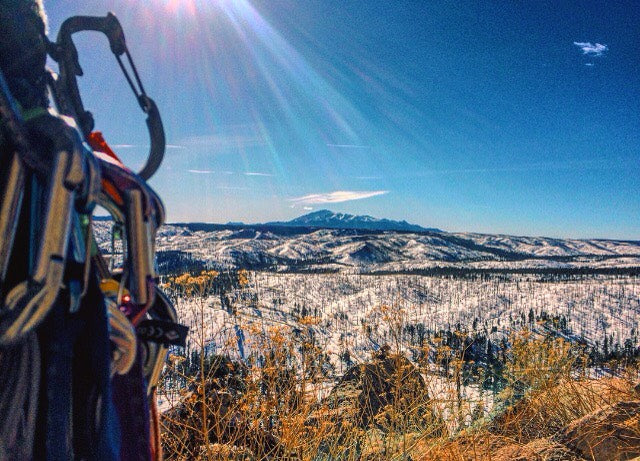
Climbing Colorado: South Platte’s “Lost in Space”
With a long spell of sunny mid winter Colorado days in the forecast, I decided it was about time to dust off the rock shoes and “dry out” on some rock. In search of a partner to join me in the unusual February cragging opening, I mentioned the idea to my Pikes Peak Alpine School co-worker, Savannah. After endless days of riding powder and corduroy, she quite literally screamed out in excitement for a chance to get away from the grueling days of snow and backcountry outings (a little strange, I know).
With a partner and a day set, Friday the 12th, I was in need of an objective. Where else would be worthy of our time on such a beautiful day besides the awe inspiring region of southern Colorado – the South Platte (or the Splatte for fellow rock hounds)? Knowing the infamous south face of Sheep’s Nose would be basking in the sunshine all day I knew what route we would be climbing – the ultra classic line “Lost in Space”. If you’re worth your weight in chalk you have climbed, dreamed of climbing, or, at least, heard of this stunning line on one of the South Platte’s most striking faces. With this being Savannah’s first day out on a bigger route, I also knew the climbing would not disappoint nor overwhelm the young padawan.
Upon arriving at the area our worries of wet, cold rock were quickly quelled as we saw the behemoth soaking up the rays, albeit, we did encounter a few postholes in to some thick areas of crusty snow that had not yet melted. This was in no way enough to deter us from our goal. Within half an hour of parking the truck, I was racked up, checking harnesses, and cruising up the first pitch.
Coming in at an average grade of 5.7, this pitch was pure enjoyment. No worries or issues befell me as I reveled in the moment. No ice tools or ski poles in hand for once – just the feel of warm, rough, South Platte granite that we all know and love so much. Upon reaching the end of the pitch, I built an anchor, pulled the rope up, and told Savannah to get her climb on and join me on this amazing piece of rock. She quickly followed, only to meet me at the belay ledge with a grin from ear to ear.

The second pitch, as per usual, came with its usual confusions. This being my third time on the route, I was still none the wiser about which direction was the “correct” way to go. Yet, as we all know, rock climbing is an art. In the world of art, there is no right or wrong way to go about things. So, after poking my head up and around every angle of rock, I decided to take the line closest to our belay; whether or not it is the true line I do not know. And what do you know? The line I chose worked brilliantly and put me right where I needed to be. This part of the climb is by far my favorite. Good protection and a series of cracks lead you up one of the most exposed aretes you can find. I flowed through the climbing and found myself on a small stance below the dreaded 5.9 slab. Knowing this small, technical section of slab is still (in theory) part of the second pitch, it would be a nightmare to try to climb it with the drag I had mustered on the previous 100 feet of climbing. So, with a little hesitation, I built a belay on the tin ledge and tugged the ropes three times to tell Savannah it was go time.
To her dismay this would be her first true taste of painfully small belay stances. She let me know in her best way how awful it was having to share a 1′ by 1′ chunk of “belay stance” with me and my over-sized runner’s legs. Although I explained to her it was a necessary evil due to the heinous drag, I believed it mattered very little to her. We squirmed and grunted while organizing rope and gear, but after ten minutes, I was ready to go. I carefully moved on to this ten foot section of slab and placed as much protection in the thin, flaring, dubious at best crack. With a hop, skip, and a five minute long breath I was off the tenuous section of slab and cruising up some easy, enjoyable climbing to our final belay stance.

This one turned out to be much more pleasurable for both Savannah and myself as it offers at least a foot or two more of wiggle room (literally). The final pitch was just icing on the cake at this point. The climbing is extremely enjoyable and well protected. After a couple hundred feet or so, you find yourself on one of the coolest summits in the region with miles and miles of gorgeous landscape and mountains to take in. I quickly set up a belay and brought Savannah up to join me in victory. Of course, when she arrived, words could not express the stoke level she was experiencing. Her first big climb ended up being an awesome day in an amazing setting.
“Lost in Space” is an amazing route that provides an adventurous feel while being relatively close to the car and civilization. The climbing never gets harder than 5.9, with that being a very small section at that. The face is one of the warmest you can find in the area and the approach is nothing more than a twenty minute romp up some boulders. I highly encourage any experienced climbers looking for a great day out to go check it out. If you are running low on chalk, quick draws or cams we’ve got you covered at Mountain Chalet. If you’re not quite ready to take your first lunge on to bigger, trad routes call Pike’s Peak Alpine School for some great guidance and a safe teacher.
BETA: Climbing Colorado “Lost In Space”
Route: “Lost In Space”
Rating: 5.9, Grade III, Trad
Pitches: 5.8 (150’), 5.9 (175’), 5.7 (140’), 5.4 (215’)
Standard Rack
Location: West Stump Road, South Platte, Co
Coordinates: 39.14092N, -105.19385W
First Ascent: Ed Lynch, John Pease 1974
For more beta on “Lost In Space” and other routes, review South Platte Climbing: The Thunder Ridge and Turkey Rock Edition
The post Climbing Colorado: South Platte’s “Lost in Space” appeared first on Mountain Chalet.


